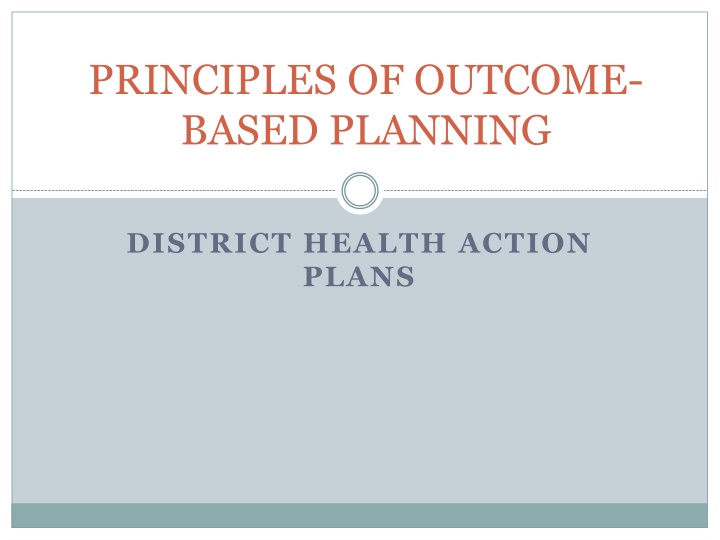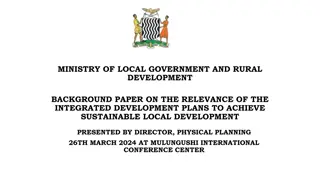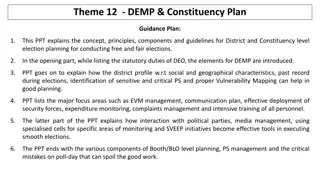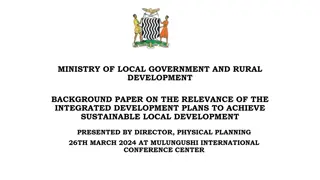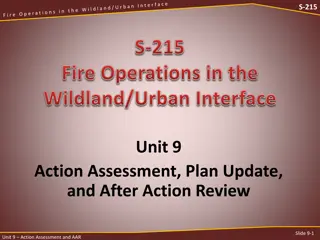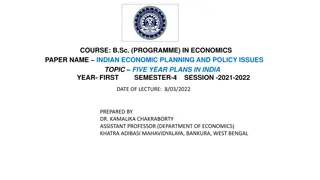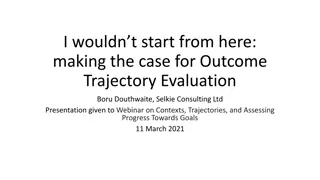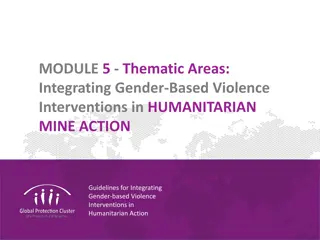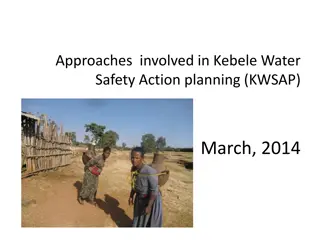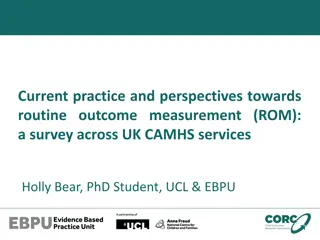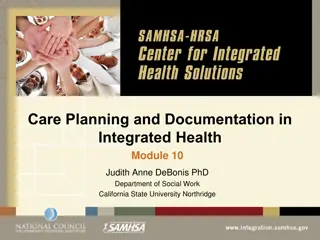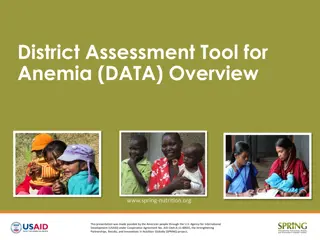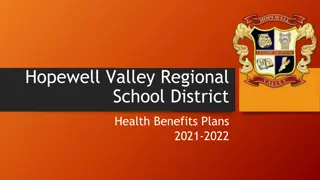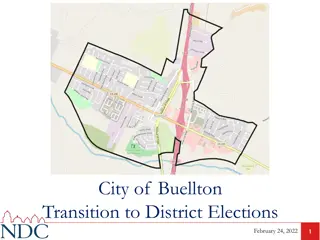Principles of Outcome-Based Planning in District Health Action Plans
District Health Action Plans are essential for planning, implementing, and monitoring health activities at the district level. These plans focus on achieving health-related outcomes, ensuring universal access to quality services, community participation, and resource allocation for reducing out-of-pocket expenses. The process involves deciding on outcomes, choosing strategies based on evidence, and involving stakeholders in participatory planning.
Download Presentation

Please find below an Image/Link to download the presentation.
The content on the website is provided AS IS for your information and personal use only. It may not be sold, licensed, or shared on other websites without obtaining consent from the author.If you encounter any issues during the download, it is possible that the publisher has removed the file from their server.
You are allowed to download the files provided on this website for personal or commercial use, subject to the condition that they are used lawfully. All files are the property of their respective owners.
The content on the website is provided AS IS for your information and personal use only. It may not be sold, licensed, or shared on other websites without obtaining consent from the author.
E N D
Presentation Transcript
PRINCIPLES OF OUTCOME- BASED PLANNING DISTRICT HEALTH ACTION PLANS
WHY District planning 2 The District Health Action Plan would be the main instrument for planning, Inter-sectoral convergence, implementation and monitoring of the activities under the Mission. Rather than funds being allocated to the states for implementing programmes designed and approved at the GOI level, the States would be encouraged to prepare their perspective and annual plan which in turn would be based on the District Plans Broad Framework for Preparation District Health Action Plan Objectives of DHAP : Thus a district health plan is an action plan for implementation, and monitoring. the health related outcomes. To ensure minimum standards of universal access to quality health services-RCH, communicable diseases, non communicable diseases To ensure outcomes and to make them explicit and public with the road-map on which the district is expected to proceed towards universal health care. Ensure facility development required is evidence based and source of evidence must come from triangulated data of which at least one source has to be local to ensure context specific, need based planning ..
Objectives of DHAP 3 Ensure that priorities for facility and its services are addressed. 5. To ensure community participation in deciding the content of the package and in the choice of the technology. 6. To ensure careful resource allocation to the district and facilities that lead to substantial reductions of out-of pocket expenditures for all elements of care as provided by public health facilities.
STEP -1: Decide on Outcomes 4 Decide on Outcomes- or Programme Objectives- Based on Both Situation Analysis and Goals i.e- based on where we are and where we want to go. Outcome is where we can reach in one year or in the plan period. Use outcome indicators to set measurable objectives and to measure whether we have reached it. Impact indicators to measure the progress with respect to goals.
STEP-2: The Choice of Strategy. 5 Make Choice of Strategy/Strategies needed to reach Objectives. Output Indicators measure how far the strategy was implemented. Example Objective is to lower neonatal mortality from 30 per 1000 to 20 per 1000. Strategy choice could be between a. making every 24*7 pHC into a newborn stabilisation facility or only those which are FRUs into a newborn stabilisation, or b. for choose between AWWs or ASHAs to train on home based care . Output indicator would be how many sick children referred in newborn stabilisation unit or it could be number of ASHAs or AWWs who made all mandatory visits to the newborn and newborn weighing efficiency etc. Choice of Strategy: Evidence Based: What works and to what extent and in what circumstances: Also on how much human and financial resources available.
Participatory Processes- when and how 6 Participation in planning is best done if situation analysis, objective and choice of strategy is shared with stakeholders. This could take the form of a brief document. Activities, budgets, timelines need not be spelt out. Stakeholder groups could comment on situation analysis. modify objectives by adding in more objectives or setting priorities, Commenting on choice of strategy. Ideally talk to a)PRIs, b) block officers, c) cross-section of health staff,d) some civil society groups e) village health and sanitation committees- some of them would only comment on objectives and priorities, others would comment on all three aspects.
Step 4: Activities- Budgets- Timelines 7 Once the choice of strategy is made- the next steps are more mechanical and internal- but it takes a lot of expertise and hard work to get it right. Break up every strategy into a set of activities. Most strategies break up into activities under 5 or 6 heads- infrastructure, HR, procurement of equipment, drugs and supplies, training, management including supervision, and maybe a community level activity or demand side funding. Every activity would have a budget-line and a timeline All the above can be captured in one or two tables. Every activity with a budget line would have a process/activity and input indicator to measure whether these activities happenned.
Step 5- Putting it together- the Plan document 8 Components of the Plan document- RCH Component: maternal health, Newborn and Child health including nutrition, Immunisation, Family Planning, RTIs and ARSH, Disease control plans Facility Development Component- Infrastructure, HR, Training Facilities. Community Processes including BCC About three pages for each component- stating situation analysis, objectives, choice of strategy and a table showing activities and budget line. Budget lines should have a cross reference number to final budget standard format . But all aspects of the component should be shown here. Final Budget should be based on Standard Approved Format. But if we look at each component we should be able to see how each activity relates to final budget.
General Principles for Improving Planning Process 9 1. Based on Health service delivery and health status information as gleaned from HMIS- and secondarily from other sources 2. Based on epidemiological profile as gleaned from information of disease control programmes and IDSP- and hospital data/surveys where needed. 3. Choice of facilities to prioritise for development- both on access and on volume- but also to ensure universal access. 4. Community Processes Planning : provide for mid-level management 5. District Plans must lend themselves to Aggregation into a state plan and vice versa disaggregationinto district resource allocation- standard budget format ensures this. Linkage between text of plan(situation analysis, objectives, strategies) and physical achievement targets, and financial resources ( activities, budgets, time-lines)- the tables in the end of each component ensure this- as far as possible standardise standardise these formats- but cross reference to standard budget format a must Linkage between physical and financial targets( reflecting activities) and utilisation of services, service delivery and health outcomes. (see facility development plan)
Outcome based Facility Development District Plan Package of Services: Clearly decide the package of services that a facility would provide and the levels of such care needed in different facilities. Define standards for HR, Infrastructure, Equipment and Supplies and support services needed for quality care 1. Identifying Facilities for Strengthening: Decide what service package would be provided in each facility- existing and those to be strengthened. 2. Close Gaps in HR and Infrastructure in identified facilities- this will ensure that HR and infrastructure matches outputs. 3. Close gaps in skills : Estimate precise training load and prioritise.- this will ensure that training relates to improved outputs and quality. 4. Differential financing- Provide more funds to those facilities, public or private and those providers who provide a greater volume, range and quality of services. 5. Transport and Communication Linkages between Facilities. 6.
Process of identifying facilities 12 Maps showing all facilities List of facilities with current case loads Mapping: which village uses which facility- distances and time taken. Note Peoples Preferences: Where would they like to have the facility? Consultative ,Participatory Process- Finalising Facility: looking at geographical feasibility, case load, population served Principle: UNIVERSAL ACCESS IS ENSURED but because of development of transport; health seeking behavior changes, segregation of package of services - a lessor number of facilities -can guarantee this for some types of services.
PROCESS OF PLAN PREPARATION 13 PREREQUISITES: HMIS analysis of performance indicators, latest data Demographic characteristics and basic information from surveys (e.g. mortality figures, TFR etc.) List of all functional and potentially functional health facilities (including private facilities) with current level of service delivery Small scale maps of blocks and districts where facilities are shown ( Level 1, 2 and 3)
Budget 14 Finalize the Standard Budget Format- in consultation with the national center/ GOI . Standardise Unit Costs- if necessary different unit costs for different district types. Set standards for every facility, for every activity( IPHS and MNH for RCH Prepare three to five model district plans- for others to have benchmark.
Structure of a District Health Action Plan 15 District Background ( with maps) Overall situation analysis of the district ( on health indicators using HMIS, survey data) Programme sections : RCH+ MFP ( Common Flexible pool), NDCP, NCP Facility development plan Over all budget Annexures
16 Thank you !
